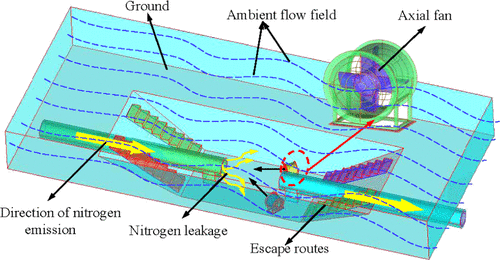Our official English website, www.x-mol.net, welcomes your feedback! (Note: you will need to create a separate account there.)
Study on Gas Diffusion in Fire Working Areas of Oil and Gas Pipelines Based on Temperature Difference
ACS Omega ( IF 3.7 ) Pub Date : 2020-09-30 , DOI: 10.1021/acsomega.0c03161 Dengfeng Zheng 1, 2 , Zhongan Jiang 1 , Jing Qu 2 , Mingxing Zhang 2 , Xiaoyan Hao 1 , Guoliang Zhang 1 , Jiuzhu Wang 1 , Yapeng Wang 1
ACS Omega ( IF 3.7 ) Pub Date : 2020-09-30 , DOI: 10.1021/acsomega.0c03161 Dengfeng Zheng 1, 2 , Zhongan Jiang 1 , Jing Qu 2 , Mingxing Zhang 2 , Xiaoyan Hao 1 , Guoliang Zhang 1 , Jiuzhu Wang 1 , Yapeng Wang 1
Affiliation

|
When a pipeline is under fire safety work construction, the stack effect of the pipeline will increase the diffusion rate of nitrogen, reduce the oxygen content, and cause asphyxia. To prove the influence of the stack effect of the pipeline on the nitrogen movement in the pipeline and put forward effective ventilation control measures, the formation mechanism, gas diffusion law, and ventilation parameters of the stack effect of the oil and gas pipelines are studied through theoretical derivation and numerical simulation. The results show that the nitrogen concentration at the height of the breathing zone in the hot zone first increases and then decreases along the axial distance. The larger the temperature difference, the faster the diffusion speed of nitrogen in the fire safety work area, and the lower the oxygen concentration. When the temperature difference increases to 30 °C, the maximum oxygen concentration in the work area is 0.177; to control the problem of low oxygen content caused by the stack effect, three ventilation schemes are put forward. Through the analysis that installing fans symmetrically on both sides, 4 m away from the pipe opening, can effectively reduce the stack effect intensity when the optimal working wind speed of the fan is 4 m/s. The findings of this study can help in better understanding the causes of the chimney effect during pipeline fire safety work and provide theoretical basis for controlling personnel suffocation caused by the chimney effect.
中文翻译:

基于温差的油气管道火灾工作区气体扩散研究
当管道进行消防安全施工时,管道的堆积效应会增加氮的扩散速率,降低氧含量,并引起窒息。为了证明管道的叠加效应对管道中氮运动的影响,并提出有效的通风控制措施,研究了油气管道叠加效应的形成机理,气体扩散规律和通风参数。理论推导和数值模拟。结果表明,热区呼吸区高度的氮浓度沿轴向距离先升高后降低。温差越大,氮在消防安全工作区内的扩散速度越快,氧浓度越低。当温度差增加到30°C时,工作区域中的最大氧气浓度为0.177;当工作区域中的最大氧气浓度为0.177时,工作区域中的最大氧气浓度为0.177。为控制烟囱效应引起的低氧含量问题,提出了三种通风方案。通过分析,在风扇的最佳工作风速为4 m / s时,在距开孔4 m的两侧对称安装风扇可以有效降低烟囱效应强度。本研究结果有助于更好地了解管道消防安全工作中烟囱效应的成因,为控制烟囱效应引起的人员窒息提供理论依据。提出了三种通风方案。通过分析,在风扇的最佳工作风速为4 m / s时,在距开孔4 m的两侧对称安装风扇可以有效降低烟囱效应强度。本研究结果有助于更好地了解管道消防安全工作中烟囱效应的成因,为控制烟囱效应引起的人员窒息提供理论依据。提出了三种通风方案。通过分析,在风扇的最佳工作风速为4 m / s时,在距开孔4 m的两侧对称安装风扇可以有效降低烟囱效应强度。本研究结果有助于更好地了解管道消防安全工作中烟囱效应的成因,为控制烟囱效应引起的人员窒息提供理论依据。
更新日期:2020-10-13
中文翻译:

基于温差的油气管道火灾工作区气体扩散研究
当管道进行消防安全施工时,管道的堆积效应会增加氮的扩散速率,降低氧含量,并引起窒息。为了证明管道的叠加效应对管道中氮运动的影响,并提出有效的通风控制措施,研究了油气管道叠加效应的形成机理,气体扩散规律和通风参数。理论推导和数值模拟。结果表明,热区呼吸区高度的氮浓度沿轴向距离先升高后降低。温差越大,氮在消防安全工作区内的扩散速度越快,氧浓度越低。当温度差增加到30°C时,工作区域中的最大氧气浓度为0.177;当工作区域中的最大氧气浓度为0.177时,工作区域中的最大氧气浓度为0.177。为控制烟囱效应引起的低氧含量问题,提出了三种通风方案。通过分析,在风扇的最佳工作风速为4 m / s时,在距开孔4 m的两侧对称安装风扇可以有效降低烟囱效应强度。本研究结果有助于更好地了解管道消防安全工作中烟囱效应的成因,为控制烟囱效应引起的人员窒息提供理论依据。提出了三种通风方案。通过分析,在风扇的最佳工作风速为4 m / s时,在距开孔4 m的两侧对称安装风扇可以有效降低烟囱效应强度。本研究结果有助于更好地了解管道消防安全工作中烟囱效应的成因,为控制烟囱效应引起的人员窒息提供理论依据。提出了三种通风方案。通过分析,在风扇的最佳工作风速为4 m / s时,在距开孔4 m的两侧对称安装风扇可以有效降低烟囱效应强度。本研究结果有助于更好地了解管道消防安全工作中烟囱效应的成因,为控制烟囱效应引起的人员窒息提供理论依据。









































 京公网安备 11010802027423号
京公网安备 11010802027423号